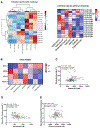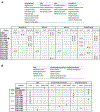APOE ε4 and Alzheimer's disease diagnosis associated differences in L-carnitine, GBB, TMAO, and acylcarnitines in blood and brain
- PMID: 36436355
- PMCID: PMC10066735
- DOI: 10.1016/j.retram.2022.103362
APOE ε4 and Alzheimer's disease diagnosis associated differences in L-carnitine, GBB, TMAO, and acylcarnitines in blood and brain
Abstract
Background: The apolipoprotein E (APOE) ε4 allele, involved in fatty acid (FA) metabolism, is a major genetic risk factor for Alzheimer's disease (AD). This study examined the influence of APOE genotypes on blood and brain markers of the L-carnitine system, necessary for fatty acid oxidation (FAO), and their collective influence on the clinical and pathological outcomes of AD.
Methods: L-carnitine, its metabolites γ-butyrobetaine (GBB) and trimethylamine-n-oxide (TMAO), and its esters (acylcarnitines) were analyzed in blood from predominantly White community/clinic-based individuals (n = 372) and in plasma and brain from the Religious Order Study (ROS) (n = 79) using liquid chromatography tandem mass spectrometry (LC-MS/MS).
Findings: Relative to total blood acylcarnitines, levels of short chain acylcarnitines (SCAs) were higher whereas long chain acylcarnitines (LCAs) were lower in AD, which was observed pre-clinically in APOE ε4s. Plasma medium chain acylcarnitines (MCAs) were higher amongst cognitively healthy APOE ε2 carriers relative to other genotypes. Compared to their respective controls, elevated TMAO and lower L-carnitine and GBB were associated with AD clinical diagnosis and these differences were detected preclinically among APOE ε4 carriers. Plasma and brain GBB, TMAO, and acylcarnitines were also associated with post-mortem brain amyloid, tau, and cerebrovascular pathologies.
Interpretation: Alterations in blood L-carnitine, GBB, TMAO, and acylcarnitines occur early in clinical AD progression and are influenced by APOE genotype. These changes correlate with post-mortem brain AD and cerebrovascular pathologies. Additional studies are required to better understand the role of the FAO disturbances in AD.
Keywords: APOE; Acylcarnitines; Alzheimer's disease; L-carnitine; Lipidomics; TMAO, GBB.
Copyright © 2022 Elsevier Masson SAS. All rights reserved.
Conflict of interest statement
Declaration of Competing Interest The authors declare no competing interests.
Figures







References
-
- Bertram Lars, Lill Christina M., McQueen Matthew B., Roehr Johannes T., Brit-Maren M Schjeide LMS. AlzGene [Internet]. 2010. [cited 2022 Mar 21]. Available from: http://www.alzgene.org/meta.asp?geneID=83
Publication types
MeSH terms
Substances
Grants and funding
LinkOut - more resources
Full Text Sources
Medical
Miscellaneous

